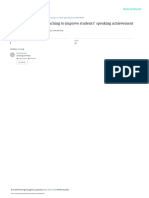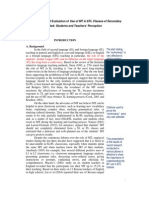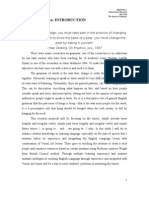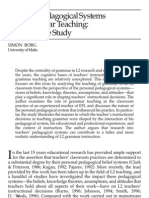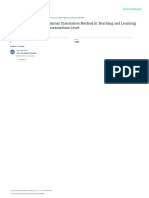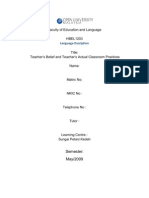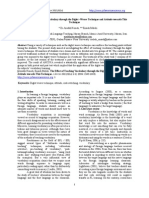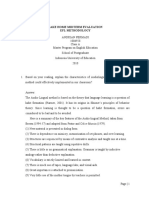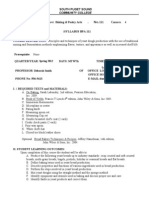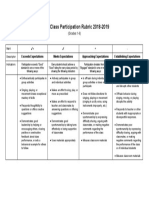Pedagogical Practices of English Language Lessons in Malaysian Primary Schools: A Discourse Analysis
Pedagogical Practices of English Language Lessons in Malaysian Primary Schools: A Discourse Analysis
Uploaded by
Dhannesh SweetAngelCopyright:
Available Formats
Pedagogical Practices of English Language Lessons in Malaysian Primary Schools: A Discourse Analysis
Pedagogical Practices of English Language Lessons in Malaysian Primary Schools: A Discourse Analysis
Uploaded by
Dhannesh SweetAngelOriginal Title
Copyright
Available Formats
Share this document
Did you find this document useful?
Is this content inappropriate?
Copyright:
Available Formats
Pedagogical Practices of English Language Lessons in Malaysian Primary Schools: A Discourse Analysis
Pedagogical Practices of English Language Lessons in Malaysian Primary Schools: A Discourse Analysis
Uploaded by
Dhannesh SweetAngelCopyright:
Available Formats
ISSN 1798-4769
Journal of Language Teaching and Research, Vol. 2, No. 3, pp. 626-639, May 2011
2011 ACADEMY PUBLISHER Manufactured in Finland.
doi:10.4304/jltr.2.3.626-639
Pedagogical Practices of English Language
Lessons in Malaysian Primary Schools: A
Discourse Analysis
Rosniah Mustaffa
Universiti Kebangsaan, Malaysia
Email: rosniah@ukm.my
Idris Aman
Universiti Kebangsaan, Malaysia
Email: idrisa@ukm.my
Teo Kok Seong
Universiti Kebangsaan, Malaysia
Email: teokok@ukm.my
Noorizah Mohd Noor
Universiti Kebangsaan, Malaysia
Email: izah@ukm.my
AbstractDiscourse analysis as a sub-discipline of linguistics is useful in understanding the teaching and
learning process and practices of a language. In line with that, this article applies discourse analysis
framework in discussing the classroom pedagogical discourse practices of English language lessons at primary
school level in Malaysia. The discussion is based on three case studies conducted in the state of Melaka. The
pedagogical discourse in the classrooms was observed, audio recorded and later transcribed and analysed. The
pedagogical discourse analysed focuses on the teachers and students practices. Among the teachers practices
identified were questioning, accepting and explaining where as the students practices were answering and
listening. These pedagogical practices are discussed in relation to their types, place of occurrences in the
discourse and their related examples. The discussion hopes to give details on how linguistics, especially
discourse analysis, benefits in language pedagogy and at the same time, enlightens the practices of English
language lessons in the classrooms.
Index Termsdiscourse practice, pedagogical discourse, English language, primary school
I. INTRODUCTION
Discourse analysis has to do with analyzing the relationship among language and the contexts in which it is used. It is
also being applied in various researches such as in applied linguistics, and second language learning and teaching. As
such, discourse analysts investigate language in use: all types of written texts and spoken data, from conversation to
highly institutionalized types of talk. For teachers, a more accurate picture of natural discourse, can put them in a better
position to assess the teaching material, what transpires in the classroom, and the end products of their teaching, either
in the form of spoken or written output (McCarthy, 1991).
Analysis of classroom discourse is useful when examining the effectiveness of teaching methods and the types of
student-teacher interaction (Richards, Platt, & Platt, 1992) Classroom discourse refers to the type of language use that is
found in classroom situations. This student-teacher discourse is also referred to as pedagogic discourse, and it is
different in form and function from language used in other situations due to the distinct social roles of students, teachers
and the activities they are engaged in (Richards et. al., 1992; Rosniah & Idris, 2005). According to Walsh (2006), the
communication patterns found in language classrooms are different from those found in content-based subjects.
Communication is distinctive because the linguistic forms utilized are often the aim of a lesson and the means of
achieving those aims.
In the L2 classroom, it is common that teacher controls both the content and the procedure of the learning-process.
According to Cazden (in Walsh, 2006) some of the features of L2 classroom are: teachers control the topic of discussion;
teachers control who can participate and when; students take their cues from teachers; role relationships among teachers
and learners are lopsided; teachers are responsible for managing the interaction which occurs; teachers talk more. Any
L2 lesson can be perceived as a dynamic and complex series of interrelated contexts, in which interaction is essential to
2011 ACADEMY PUBLISHER
JOURNAL OF LANGUAGE TEACHING AND RESEARCH
627
teaching and learning. Class-based L2 learning is often improved when teachers have a detailed understanding of the
relationship between teacher talk, interaction and learning opportunity (Walsh, 2006).
This paper applies discourse analysis framework in discussing the classroom pedagogical discourse practices of
English as a second language lessons at primary school level in Malaysia. The pedagogical discourse in the classrooms
was observed, audio recorded, transcribed and later analysed. The aims were to identify the teachers and students
practices in the classrooms.
II. DATA
The data collected for this paper were through case studies of three classroom discourses of three teachers teaching
Year 4 and 5 pupils in city of Melaka. The first teacher [text 1] was a female teacher who had a diploma. She had been
teaching English for 13 years and the topic of her standard 5 lesson was World of Stories (The Golden Touch). The
second teacher [text 2] was also female with a certificate in teaching Tamil language and had been teaching English for
2 years. Her standard 4 lesson for that day was using a letter (for comprehension and grammar). The final teacher [text 3]
was a male teacher who also had a certificate in teaching English. He had been teaching English for 28 years and his
standard 5 lesson for this study was World of Stories (Mat Janim and the Oil). Each class lesson lasted for an hour and
as such, the total length of the discourse was 3 hours. Three classroom discourses were chosen because each discourse
contains 1055, 1329, 1218 utterances respectively [a total of 3602 utterances]. The discourse was collected through
direct audio recording during the lessons. The whole process took place in April 2009. Recordings were transcribed into
texts and sort into moves and utterances. To easily manage the analysis, each utterance is given a number as shown
below.
(1)
Particapants Move Utterances
Speech Functions
T (Teacher): [712] What (do) you call this?
[Questioning]
P ( Pupil ):
[713] Eat
[Answering]
T:
[714] Aa..eat
[Repeating]
[715]
Ate
[Correcting]
[716] Its past tense of?
[Questioning]
P:
[717] Food
[Answering]
T
[718] No
[Rejection]
(Source Text 2)
III. PEDAGOGICAL PRACTICES
Practices in this paper refer to the utterances as functional units in communication. Searle (1981) termed this as
speech acts and Fairclough (1982), as speech functions. According to Searle (1981) there are 5 main speech acts or
functions. They are 1. Commissive, 2. Declarative, 3. Directive, 4. Expressive, 5. Representative which can be detailed
further, such as, a commissive can be a promise or threat; a declarative can be a command or a request; and a
representative can be an assertion or a report.
For example, in (1), when the teacher in Move [712] asks what you call this? The speech function is questioning.
When a student responds by saying eat, the speech act is answering. In move [714] the teacher repeats aaeat and
corrects the answer in move [715] by saying ate. Again in move [716] the speech act is questioning when the teacher
asks its past tense of? And when the student responds by saying food in move [717], the speech function is answering.
In move [718], the teacher says no using the speech function of rejecting the answer.
In general, the focus of classroom discourse textual analysis is on features of teacher-student interaction. Generally,
interactive control in discourse is concerned with ensuring that interaction takes place effectively at specific levels of
organization, for example systems of smooth distribution in turn taking, topic selection and exchange as well as
question-answering (Fairclough, 1992). The discourse practices discussed in this paper are the teachers and students
practices revealed in the three texts.
IV. TEACHERS PRACTICES
Among teachers practices founded are questioning, accepting, explaining, informing, instructing, correcting, rejecting,
modeling etc. The occurrences of the practices are shown in Table 1.
2011 ACADEMY PUBLISHER
628
JOURNAL OF LANGUAGE TEACHING AND RESEARCH
Practices
Questioning
Informing
Accepting
Instructing
T Ques & Ans
Modeling
Correcting
Praising
Rejecting
Translating
Explaining
Ignoring
Joking
TABLE 1
TEACHERS PRACTICES
Text 1
Text 2
345/1055
440 / 1329
60/1055
176/1329
60/1055
79/1329
51/1055
91/1329
63/1055
11/1329
0/1055
73/1329
31/1055
15/1329
5/1055
11/1329
8/1055
6/1329
13/1055
4/1329
0/1055
8/1329
0/1055
5/1329
1/1055
1/1329
Text 3
223/1218
87/1218
81/1218
58/1218
58/1218
20/1218
0/1218
14/1218
4/1218
0/1218
0/1218
0/1218
0/1218
Total
1008/3602
323/3602
220/3602
200/3602
132/3602
93/3602
46/3602
30/3602
18/3602
17/3602
8/3602
5/3602
2/3602
a) Questioning
Questioning appeared to be the most widely used speech function in these three texts. A total no of 1008/ 3602
utterances were questions. They took place 345 times in text 1, 440 in text 2 and 223 in text 3. A prominent textual
feature identified in this pedagogic discourse is the use of close-question by the teacher. Close-questions are questions
that use question words such as right/yes-no, is there, where to, who or what which merely require straight
answers or just confirmation. The use of open-questions that begin with questions-words such as why, how or
explain are limited. The following examples show the use of close-questions in the analysed discourse.
(2)
T:
[117] Do you like gold?
P:
[118] Yes.
T:
[119] It is very expensive ah nowadays.
[120]
Robbers and thieves are looking for gold.
[121]
Can you wear a lot of gold, jewelleries to weddings or when you go out to or from your house?
P:
[122] No.
(Source: Text 1)
(3)
T:
[84]
What passage is this?
[85]
Is it a poem?
Ps: [86]
No..no
T:
[87]
What is it?
Ps: [88]
Letter..letter
(Source: Text 2)
(4)
T:
[111] Its not a vase, its not a vase.
[112]
Its a Roshan?
P:
[113] Jug.
T:
[114] Its a jug aa.
[115]
Its a?
P:
[116] Jug.
T:
[117] Jug.
[118]
Ok, its a jug or a?
[119]
A jug or a?
P:
[120] Pot.
(Source: Text 3)
In (2), the teacher asked the close-questions in moves [117] and [121] which required the pupils to simply answer yes
or no. This is the most prominent textual feature used in the pedagogic discourse identified in this study in terms of
questioning techniques. Apart from yes/no answers required by the pupils, the teachers also focused on getting pupils to
supply a one word answer in (3) moves [86] and [88]. In (4) too it shows that the teacher also required the pupils to
produce one word answer as in moves [113], 116] and [120].
In the discourse analysed, there were instances when the teachers answered the questions themselves rather than
allowing students to answer. The teachers questioned but proceeded to answer them. The teachers did not provide time
for the students to think and offer their own opinions.
(5)
T:
[352] Clothes aa..like shirt, dresses, pants, that is called clothing aa
[353]
He gave them food and ?
[354]
Clothing
2011 ACADEMY PUBLISHER
JOURNAL OF LANGUAGE TEACHING AND RESEARCH
629
(Source: Text 2)
(6)
T:
[132] How you know its oil?
[133]
Again, again.
[134]
Aa the title is there aa oil, oil.
[135]
Oil inside the?
[136]
Inside the?
[137]
Pot, ok.
(Source: Text 3)
(7)
T:
[305] I want everything that I touch change into?
P:
[306] Gold
T:
[307] Gold Ok, for exx..now.
(Source: Text 1)
In (5), the teachers asked the pupils questions as can be seen in move [353] but answered it herself in move [354]
without waiting for the pupils to respond. The same goes with (6) and (7), where she answered her own questions in
move [137] and [307] respectively.
There are also instances where teachers use fishing question. What is meant by fishing questions is when teachers
provided part of the answers by mentioning the first syllable as follows.
(8)
T:
[95]
Yes, Bani?
S:
[96]
Bangle.
T:
[97]
Yes, bangle.
[98]
Ok, bang..?
P:
[99]
Gle.
T:
[100] Bangle.
(Source: Text 1)
b) Informing
Informing is to tell something. In this study, informing is the second widely used speech function with a total of
323/3602 utterances. It appeared 60 times in text 1, 176 in text 2 and 87 in text 3. The discourse analysed in this study
reflects prominently the teachers role and teaching profession. For example, this practice happens when a teacher
prefers to offer information, explanations, descriptions or answers to students rather than allowing students to discuss,
analyse or summarise in order to seek for their own answers. In other words, the teacher speaks more than the student.
Discourse is, thus, centred on the teacher. This practice can be seen below.
(9)
T:
[836] Yesterday, I put my book on your table
[837]
You dont say, yesterday I putted my book on your table
[838]
Is it correct?
[839]
No
[840]
Ok, my mother aa
[841]
Okaa
[842]
I want to cut this cake
[843]
Ok, I want to cut this cake
[844]
Aaa..yesterday, I cutted the cake aa?
[845]
I cut the cake also
[846]
Some words aa they dont change
(Source: Text 2)
(10)
T:
[968] You leave your house to go to school right?
[969]
You leave your house, ok, you left your house
[970]
This morning, I left my house at 7 oclock
[971]
All right?
[972]
This morning, I teacher left my house at 7 oclock
[973]
That means?
[974]
At 7 oclock, I came out the house
[975]
I come to school
[976]
On my way to school, ok?
[977]
Ok
[978]
Tomorrow
[979]
Ill leave home at?
2011 ACADEMY PUBLISHER
630
JOURNAL OF LANGUAGE TEACHING AND RESEARCH
[980]
6.45
(Source: Text 2)
(11)
T:
[194] After that I will give you a few questions retaining to the story aa.
(Source: Text 3)
(12)
T:
[49]
Necklace. (T put on necklace to a Ss neck)
[50]
Why?
[51]
See ah necklace is smaller than a chain.
[52]
Short and smaller
(Source: Text 1)
All instances in (9), (10) (11) and (12) illustrate an absence of interaction between the teachers and the pupils.
Teachers preferred to take the authority to inform rather than giving the opportunities for the pupils to exercise critical
thinking in discussing or analyzing a particular topic. The teachers have power over the discourse and it is unevenly
shared out with the pupils.
c) Acceptance
Acceptance is when teachers accept or acknowledge the pupils answers. This could be in a form of repeating what
the pupils said. 220/3602 of the total utterances are categorized as acceptance. It took place 60 times in text 1, 79 in text
2 and 81 in text 3.
(13)
T:
[16]
Ok, where did you go in Melaka town?
T:
[17]
One by one
P:
[18]
Menara Taming Sari.
T:
[19]
Menara Taming Sari.
[20]
Ok, where else?
P:
[21]
Mahkota Parade
T:
[22]
Mahkota Parade..some more?
(Source: Text 2)
(14)
P:
[25]
Teacher..I also went to Melaka town.
T:
[26]
Melaka town.
[27]
Ok, where did you go?
[28]
Melaka town?
P:
[29]
Carefour.
T:
[30]
Carefour.
P:
[32]
Dataran Pahlawan.
P : [33]
Mahkota Parade.
T:
[34]
Mahkota Parade.
P:
[35]
Pizza Hut.
T:
[36]
Pizza Hut..wah..so many places.
P:
[37]
And Indian shops.
T:
[38]
Indian shops..You?
[39]
Avinash?
P:
[40]
MacDonald.
T:
[41]
MacDonald.
P:
[42]
KFC
T:
[43]
KFC.
P:
[44]
Pizza Hut.
T:
[45]
Pizza Hut.
(Source: Text 2)
(15)
T:
[167] Now..look at the picture there.
[168]
What do you think the.
[169]
How?
[170]
What is the feeling of the king?
P:
[171] Very happy.
T:
[172] Aa..He is very?
P:
[173] Happy.
T:
[174] Happy
(Source: Text 1)
2011 ACADEMY PUBLISHER
JOURNAL OF LANGUAGE TEACHING AND RESEARCH
631
(16)
T:
[31]
Ok, what do you think Mat Jamin is doing?
[32]
What you think hes doing?
[33]
Yes, Firdaus?
P:
[34]
He is dreaming.
T:
[35]
He is?
P:
[36]
Dreaming.
T:
[37]
He is dreaming.
(Source: Text 3)
Acceptance can be seen in (13) where the teacher repeated what the pupil responded as in moves [19] and [22]. The
same goes in moves [26], [30], [34], [36], [41], [43] and [45] in (14), where again the teacher repeated what the pupils
answered. This scenario is repeated once more in moves [174] in (15) and finally in moves [37] in (16). Usually the
teacher employed the actions of acceptance to indicate that the answers provided by the pupils were correct.
d) Instructions
Instruction is where teachers instruct the pupils to do something. In this study it is found that instruction is the fourth
widely used practice. It appears 200/3602 times with 51, 91 and 58 times in texts 1, 2 and 3 respectively.
(17)
T: [187]
Ok, now, you look at the story, look at the story, I let you look at the story and you read silently, aaa.
[188]
For 4 minutes.
(Source: Text 3)
(18)
T:
[615] Once you get the paper, write down your name, and the..todays date.
[616]
Pass aaa..
[617]
Ok, class..the earlier one aa, the comprehension passage, class, pay attention, Govinath!
[618]
Class, this comprehension passage aa, you will need to cut and paste in your English 1, and you copy
the questions and you answer them.
[619]
Ok?
[620]
The passage you cut and paste, then based on this, you answer the questions.
(Source: Text 2)
(19)
T:
[147] Dont read the story first aa.
[148]
Look at the picture first.
(Source: Text 1)
In giving instructions, usually the teachers employed this practice when it was time to do exercises or to work on a
given tasks. Instructions were given to ensure the pupils understand and know what to do to complete the given tasks.
Examples of this can be seen in (17) moves [187] where the teacher instructs the pupils to read the story silently and in
(18), moves [618] and [620] the teacher gives instructions to the pupils what to do with the comprehension passage. In
(19), the teacher instructs pupils what to do and what not to do first as depicts in moves [147] and [148].
e) Question and answer
Apart from the teachers asking questions for students to answer as mentioned earlier, there is another type of practice
that the teacher employed in the classrooms. This is by asking pupils questions but not giving the thinking time for the
pupils to think of the answers expected. The teachers instead answer their own posed questions and this happened 63,
11 and 58 times in texts 1, 2 and 3 respectively giving a total of 132/3602 times of the total utterances.
(20)
T:
[252] King Midas was a rich?
[253]
King.
[254]
Although hes rich but he loves gold.. anyone what?
[255]
More
P:
[256] More than.
T:
[257] Golds aa..although hes rich but he want more?
[258]
Golds.
(Source: Text 1)
(21)
T:
[269] What a fairy always hold?
[270]
A star like this, right?
[271]
Tingg aa..magic?
[272]
Stick aa.
[273]
Always changed everything when it says ting aa you change to what?
[274]
Frog?
[275]
Then you will jump like a?
2011 ACADEMY PUBLISHER
632
JOURNAL OF LANGUAGE TEACHING AND RESEARCH
[276]
Frog.
[277]
Ok, then it says what?
[278]
Ting..it will what?
[279]
It will give whatever you?
[280]
Want
(Source: Text 1)
(22)
T:
[267] Or you can write, Francis went to the old folks home on 19th October 2007.
[268]
Understand or not?
[269]
Ok, you should based on the letter.
[270]
The letter stated he wrote the letter on the?
[271]
20th October..right or not, class?
[272]
So, when hes saying the letter yesterday, he went to the old folks home, that means?
[273]
20th he wrote the letter, yesterday means?
[274]
The day before 20th, right?
(Source: Text 2)
(23)
T:
[319] Ok, not long ago, we use the term dollars.
[320]
Instead of?
[321]
Instead of?
[322]
Ringgit
(Source: Text 3)
(24)
T:
[328] What other words you do not understand?
[329]
Hire.
[330]
Do you know the word hire?
[331]
H.I.R.E.
(Source: Text 3)
In (20), move [254] the teacher asked the pupils but answered her own question as in move [258]. This is more
obvious in (21) where the teacher asked 6 questions [269], [271], [273], [275], [277], [279] but proceeded to answer
them all in moves [270], [272], [274], [276], [278] and [280]. This practice is further employed in (22) where the
teacher asked questions in [270] and [273] but proceeded to answer them in moves [271] and [274] respectively. The
same can be seen in (23) where the teacher asked instead of? in move [321] and answered it herself, Ringgit in
move [322]. This practice is repeated in (24) where the teacher asked the pupils how to spell hire in move [330] but
she proceeded to spell it herself in move [331] without waiting for the pupils to contribute their answers.
f) Modelling
Teachers used 93/3602 of the total utterances to model the correct way of pronouncing words and also to have the
pupils to repeat after them. However in text 1, no modeling was used by the teacher as compared to 73 in text 2 and 20
in text 3.
(25)
T:
[1088] I want you to go this one again aa.
[1089] Wash.
P:
[1090] Wash.
T:
[1091] Washed.
P:
[1092] Washed.
T:
[1093] Walk.
P:
[1094] Walk.
T:
[1095] Walked.
P:
[1096] Walked.
T:
[1097] Bring
P:
[1098] Bring
(Source: Text 2)
(26)
T:
[220] Ok, read the title 1st.
[221]
Mat Jamin and the oil.
P(Gp1)[222] Mat Jamin and the oil. (Reading the 1st paragraph)
T:
[223] Ok, very good.
[224]
Can you please sit down?
[225]
Ok, the 2nd group, can you read the 2nd paragraph?
P(Gp2)[226] He..
2011 ACADEMY PUBLISHER
JOURNAL OF LANGUAGE TEACHING AND RESEARCH
633
T:
[227] He..
P(Gp2):[228] He (Reading the 2nd paragraph )
T:
[229] I will sell?
P(Gp2):[230] (Continue reading the 2nd paragraph)
T:
[231] He thought.
P(Gp2):[232] (Continue reading the 2nd paragraph)
(Source: Text 3)
There were many instances of modeling the correct pronunciation of words in text 2 and 3. Examples of such
practices can be seen in (25) from move [1089] to [1098] where the pupils model each word the teacher says. The same
with (26) where the pupils started reading the paragraph from the word or phrase modeled by the teacher as in moves
[228], [230] and [232].
g) Correcting
Teachers usually use corrections in the classrooms. What was observed in the classrooms was the fact that the
teachers do corrections on the spot when the pupils made mistakes. A total of 46/ 3602 utterances were correcting the
students pronunciation with 31corrections done in text 1, 15 in text 2 and none in text 3 as shown below.
(27)
T:
[193] Ok.
[194]
Amar read.
P:
Reading passage
T:
[195] King Midas aa..(correcting the pronunciation)
P:
Continue reading passage
T:
[196] Else..anything else..(correcting the pronunciation)
P:
Continue reading passage
T:
[197] In the world. (correcting the pronunciation)
P:
Continue reading passage
(Source: Text 1)
(28)
T:
[223] Princess Stefanie (correcting the pronunciation)
P:
[224] Princess Stefanie (and continue reading passage)
T:
[225] Begged (correcting the pronunciation)
P:
[226] Begged (and continue reading passage)
T:
[227] Horrible (correcting the pronunciation)
P:
[228] Horrible (and continue reading passage)
T:
[229] Lesson (correcting the pronunciation)
P:
[230] Lesson (and continue reading passage)
T:
[231] The kind fairy (correcting the pronunciation)
P:
[232] The kind fairy (and continue reading passage)
(Source: Text 1)
(29)
T:
[127] You are.. (correcting the pronunciation)
P:
[128]
(Continue reading passage)
T:
[129] Folks (correcting the pronunciation)
P:
[130] (Continue reading passage)
T:
[131] Folks (correcting the pronunciation)
P:
[132]
(Continue reading passage)
T:
[133] Knew (correcting the pronunciation)
P:
[134] (Continue reading passage)
T:
[135] We were (correcting the pronunciation)
P:
[136] (Continue reading passage)
(Source: Text 2)
In (27), the teacher corrected the pupils pronunciation as the pupil was reading and it happened every time the pupil
mispronounced the words. The same can be seen in (28) and (29) where the teachers corrected all the pronunciations
made by the pupils as they did the readings.
h) Praise
Utterances which give compliments to the pupils are categorized as praising. The total number of utterances used as
praise is only 30/ 3602 where it is used 5, 11 and 14 times in texts 1, 2 and 3 respectively. Basically the words used
were very good instead of other compliment words.
(30)
T:
[145] Orphange (correcting the pronounciation)
P:
[146] (Continue reading passage)
2011 ACADEMY PUBLISHER
634
JOURNAL OF LANGUAGE TEACHING AND RESEARCH
T:
[147] Very good.
(Source: Text 2)
(31)
T:
[349] How do you spell rent?
S:
[350] R.E.N.T
T:
[351] Yes.
[352]
Very good.
(Source: Text 3)
(32)
T:
[543] Sit aa?
[544]
Becomes?
P:
[545] Sat!
T:
[546] Sat.
[547]
Very good.
(Source: Text 2)
(33)
T:
[62]
Chain.
[63]
Ok, what is this?
[64]
Small thingah yes..
S:
[65]
Locket.
T:
[66]
Very good
(Source: Text 1)
In (30), (31), (32) and (33), the compliment very good appeared in moves [147], [352], [547] and [66] respectively.
The teachers in all the 3 texts did not use other compliment words such as great, excellent or good. By not doing
so, the pupils were not exposed to varied vocabularies in the classroom.
i) Translating
Using translation is not uncommon in language classrooms in Malaysia. Translating could happen in the pupils
mother tongue or the national language. Teachers use translation when the pupils do not understand the word in English
and students use translation when they do not know to say the words in English. In total, only 17/3602 of the utterances
were translation words. Specifically, text 1 used 13 translation words, texts 2 used 4, while text 3 did not use any.
(34)
T:
[152] A king.
[153]
How you know he is a king?
S:
[154] He got a..(not clear)
S:
[155] Mahkota.
T:
[156] That mahkota.
[157]
What you call it in English?
[158]
What you call it in English?
[159]
It starts with the letter C.
P:
[160] Criss
T:
[161] Criss aa?
[162]
Crown.
(Source: Text 1)
(35)
T:
[262] What is fairy?
P:
[263] A small..(not clear)
T:
[264] Mm?
[265]
A small what?
[266]
Aa?
P:
[267] Pari-pari.
T:
[268] Pari-pari.
[269]
What a fairy always hold?
[270]
A star like this, right?
(Source: Text 1)
(36)
T:
[469] Gold.
[470]
He said excitedly.
[471]
What is excitedly?
T:
[472] Dengan penuh apa? (In Malay)
P:
[473] (In Tamil)
2011 ACADEMY PUBLISHER
JOURNAL OF LANGUAGE TEACHING AND RESEARCH
635
P:
[474] Sorak-sorak
T:
[475] Sorak-sorak..excitedly.
(Source: Text 1)
(37)
T:
[483] Stefanie, ok.
[484]
Hello, my little Princess, said King Midas and gave her a pat.
[485]
What is pat?
P:
[486] Chest.
P:
[487] Shoulder.
T:
[488] What are you telling?
[489]
What is that in Tamil?
P:
[490] (In Tamil)
(Source: Text 1)
(38)
T:
[103] Orphanage..Ok, what is an orphanage?
P:
[104] (In Tamil).
T:
[105] (In Tamil).
[106]
People who dont have anybody, parent, siblings aa..sisters, brothers, nobody, any relatives..K?
[107]
Its called orphanage.
[108]
Orphans aa..they are orphans.
[109]
Ok, what you call in Malay orphans?
P:
[110] Anak..
P:
[111] Anak yatim..
T:
[112] Ok, anak yatim-piatu aa..they got nobody in this world.
(Source: Text 2)
(39)
T:
[418] Past tense..right?
[419]
Good.
[420]
They are verbs.
[421]
Verbs aa.
[422]
(In Tamil).
[423]
Kata kerja.
[424]
Verbs.
(Source: Text 2)
In (34), the pupil did not know the word crown and resorted to saying mahkota in move [155]. The teacher then
translated mahkota into crown in move [162]. In (35), the pupil could not describe the meaning of the word fairy
and said the equivalent word in Malay, pari-pari in move [267]. Besides resorting to translate words intro Malay, the
pupil in (36) also used Tamil (this is a Tamil school) in move [473] to explain the meaning of excitedly besides the
Malay word sorak-sorak in move [474]. In (37), the teacher asked the pupil the meaning of the word pat in Tamil
as can be seen in move [489] and the pupil answered in Tamil in move [490]. In (38), the pupil answered in Tamil in
giving explanation of the word orphanage then the teacher explained the meaning again in English [106]. She also
asked the pupils the meaning of orphans in Malay instead of in English in move [109] and the pupil answered in
Malay in moves [110] and [111]. Interestingly in (39) the teacher explained what verbs are in Tamil [422] and in Malay
[423].
l) Jokes
Although jokes and humor in the classrooms can make the pupils relax, they are used very rarely in the classrooms. It
takes the teachers wittiness to spontaneously create jokes related to the lessons such as the ones below. Only 2/3602
utterances are considered as jokes with 1in text 1, 1 in text 2 and none in text 3.
(40)
T:
[1036] We have here?
[1037]
Sing?
P:
[1038] Yes.
T:
[1039] Where?
[1040] Here?
[1041] Over here?
[1042] Class?
[1043] Sing aa..S.I.N.G sing..not Singh aa not the Punjabi Singh.
P:
[1044] (Laugh)
(Source: Text 2)
(41)
2011 ACADEMY PUBLISHER
636
JOURNAL OF LANGUAGE TEACHING AND RESEARCH
[373] Waa, he wants an?
[374] I want an aeroplane.
[375] Aeroplane.
[376]
Ok. as a fairy, Ill give him a toy aeroplane.
[377]
Next time aa
(Source: Text 1)
There were only 2 jokes that emerged in the 3 lessons. One was in (40) where the teacher said Sing aa..S.I.N.G
sing..not Singh aa not the Punjabi Singh in move [1044] which created laughter among the pupils. The other was in (41)
where the teacher said in move [376] Ok. As a fairy, Ill give him a toy aeroplane and moved on to say in move [377]
Next time aa
T:
P:
T:
V. PUPILS PRACTICES
As for the pupils practices, the common ones are answering, repeating and questioning. Correcting was also
detected in this study, which is rare in Malaysian classrooms. The findings are shown in Table 2.
Practices
Answering
Repeating
Questioning
Correcting T
TABLE 2
STUDENT PRACTICES
Text 1
Text 2
202/1055
199/1329
29/1055
73/1329
1/1055
4/1329
0/1055
1/1329
Text 3
156/1218
0/1218
7/1218
0/1218
Total
557/3602
102/3602
12/3602
1/3602
a) Answering
As for the pupils practices, basically their main role in the classrooms were answering the teachers questions with a
total of 557/3602 utterances. In text 1, 202 of the utterances were the pupils answering the teachers questions, 199 in
text 2 and 156 in text 3. Answers were basically one word answers which were very straight forward and do not require
the pupils to think creatively.
(42)
T:
[78]
Louder ah, you must speak loud.
[79]
What is this?
[80]
What is this?
P:
[81]
Hand... (not clear)
T:
[82]
Hand ah hand so?
P & T: [83]
(Not clear)
T:
[84]
Cincin ah?
P:
[85]
Cincin.
T:
[86]
Ok. What is this?
P:
[87]
Ring.
(Source: Text 1)
(43)
T:
[138] Ok ah, what is the title of the story?
P:
[139] The Golden Touch.
T:
[140] Again?
P:
[141] The Golden Touch.
T:
[142] The Golden?
P:
[143] Touch.
T:
[144] Touch
(Source: Text 1)
(44)
T:
[474] Everyday Meena and Getha come to school by bus.
[475]
Yesterday Meena and Getha?
P:
[476] went!
T:
[477] Come becomes?
P:
[478] Came!
T:
[479] Came..came to school by?
[480]
Bus.
(Source: Text 2)
(45)
T:
[105] Yes, anybody?
[106]
Isyazwan, what is that?
2011 ACADEMY PUBLISHER
JOURNAL OF LANGUAGE TEACHING AND RESEARCH
P:
T:
P:
T:
637
[107] Vast..( wrong pronunciation)
[108] Aa?
[109] Vase.. ..( wrong pronunciation)
[110] Vase?
[111]
Its not a vase, its not a vase.
[112]
Its a Roshan?
P:
[113] Jug.
T:
[114] Its a jug aa.
[115]
Its a?
S:
[116] Jug.
T:
[117] Jug.
(Source: Text 3)
In answering the teachers questions, most answers were one word answer as can be seen in (42) moves [81] and [87].
The same goes in (43) move [143], in (44) moves [476] and [478]. In (45), the one word answers can be seen in moves
[107], [113], and [116].
b) Repeating
There are instances where teachers modeled the correct pronunciation of the words and required the pupils to repeat
after them. This practice is revealed in 102/3602 of the utterances with 29 utterances in text 1, 73 in text 2 and none in
text 3.
(46)
T:
[257] Old folks home
Ps: [258] Old folks home
T:
[259] On the
Ps: [260] On the
T:
[261] 19th of
Ps: [262] 19th of
T:
[263] October
Ps: [264] October
T:
[265] 2007
Ps: [266] 2007
(Source: Text 2)
(47)
T:
[1089] Wash.
P:
[1090] Wash.
T:
[1091] Washed.
P:
[1092] Washed.
T:
[1093] Walk.
P:
[1094] Walk.
T:
[1095] Walked.
P:
[1096] Walked.
(Source: Text 2)
(48)
T:
[573] Ok, read the first one..(Reading the dialogue and P follow)
[574]
Read la.. (Reading the dialogue and P follow)
[575]
Ok, how you read emotionally?
[576]
How you read? (Reading the dialogue and P follow)
[577]
Ok, second one. (Reading the dialogue and P follow)
(Source: Text 1)
In (46), it can be seen that the pupils repeated every word the teacher said from moves [257] to [266] and from moves
[1089] to [1096] in (47). As for (48), the pupils read after the teacher in moves [573], [574] [576] and [577].
c) Questioning
Questioning here refers to utterances which are made by the pupils in asking the teachers. Only 12/3602 utterances
were questions made by the pupils. 1 from text 1, 4 from text 2, 7 from text 3.
(49)
T:
[594] Write beside here.
[595]
Eyy..Here the story.
P:
[596] Match?
T:
[597] Aaa.
[598]
Match to the no, no you dont have to draw lines.. just number.
[699]
Just put the number aa.. put on the day.
2011 ACADEMY PUBLISHER
638
JOURNAL OF LANGUAGE TEACHING AND RESEARCH
(Source: Text 1)
(50)
T:
[700] Certain words aa.they dont change.
[701]
Any change from present tense to past tense.
[702]
Some, the pronounciation is changes but the spelling is the same.
P:
[703] Teacher, cut?
T:
[704] Cut never change.
(Source: Text 2)
(51)
T:
[374] What other words you dont understand?
[375]
Yes?
[376]
Look at the look at the story again, any words you dont understand?
[377]
You can put up your hands.
[378]
Yes?
S:
[379] Soon. (wrong pronounciation)
[380]
S.O.O.N.
T:
[381] S?
S:
[382] O.O.N.
T:
[383] S.O.O.N.
[384]
Soon.
[385]
Ok, S.O.O.N.
(Source: Text 3)
In (49), the pupil in move [596] asked the teacher for confirmation as to what they were supposed to do and the
teacher affirmed it in move [597]. In move [703], we can see that the pupil questioned the teacher the past tense form of
the word cut where the teacher in returned explained in move [704] that the spelling of cut does not change. Another
example is in (51) where the teacher asked if there were words that the pupils did not understand and the pupil in move
[379] asked the teacher the meaning of the word soon.
d) Correcting Teacher
It is a very rare occasion where we find a pupil brave enough to correct a teacher in a classroom. There is one
instance where a pupil corrected a teacher as shown below. It happened in text 2.
(52)
P:
[287] Teacher!
T:
[288] Yes?
P:
[289] Francis..Live..Melaka..teacher.
T:
[290] Yes?
P:
[291] Number 1.
T:
[292] Owh..sorry, class..number 1 aa.. where does Francis lives?
[293]
Where does Francis lives?
Ps: [294] Francis lives in Kuala Lumpur.
T:
[295] Aa..who is staying in Kuala Lumpur?
Ps: [296] Kim Seng.
Ps: [297] Kim Seng.
T:
[298] Kim Seng.
[299]
The letter was written by Francis, so, Francis lives in?
Ps: [300]
Jalan Tamarind..
T:
[301] Ok..Jalan Tamarind, Melaka.
[302]
Ok, Francis lives in Melaka.
[302]
Who lives in Kuala Lumpur?
Ps: [303] Kim Seng.
(Source: Text 2)
Here, one pupil realized that the teacher gave the wrong answer for No. 1 and the pupil corrected the teacher in move
[289]. The teacher then re-examined the content of the letter to figure out who wrote it and realized that the pupil was
right. This happened throughout moves [292] until [303].
VI. CONCLUSION
The analysis depicts the real situations in the classrooms. From the teachers and pupils practices observed and
analysed in English language classrooms, the teaching and learning of English language in Malaysia is still teacher
oriented where teachers used mostly questioning, informing, instructing, accepting, modelling and correcting. Students
were only given the opportunities to answer one word answer and repeat after the teacher. Nevertheless, there are still
2011 ACADEMY PUBLISHER
JOURNAL OF LANGUAGE TEACHING AND RESEARCH
639
rooms for improvement on some of the ways in which teachers normally carry out their lessons, giving more
opportunity for the pupils in practicing using the language in more meaningful ways.
ACKNOWLEDGEMENT
This paper is based on UKM-GUP-JKKBG-08-08-032 research project. We would like to express our gratitude to the
Ministry of Education and the schools involved for their cooperation in this study.
REFERENCES
[1]
[2]
[3]
[4]
[5]
[6]
Fairclough, N. (1992). Discourse and social change. Cambridge: Polity Press.
McCarthy, M. (1991). Discourse analysis for language teachers. Cambridge: Cambridge University Press.
Richards, I.C., Platt, J. & Platt, H. (1992). Longman dictionary of language teaching and applied linguistics. Essex: Longman.
Rosniah Mustaffa & Idris Aman. (2005). A Critical Discourse Analysis of the Teaching and Learning of L1 in Malaysia.
Proceedings of the International Conference on Critical Discourse Analysis: Theory into Research. Editor: Thao Le. University
of Tasmania. November. Pp. 502-517.
Searle, J. R. (1981). Speech acts. London: Cambridge University Press.
Walsh, S. (2006). Investigating classroom discourse. London: Routledge.
Rosniah Mustaffa, Ph.D (Malaya) is Associate Professor at the School of Language Studies and Linguistics, Faculty of Social
Sciences and Humanities, Universiti Kebangsaan Malaysia.
Idris Aman, Ph.D (Malaya) is Associate Professor at the School of Language Studies and Linguistics, Faculty of Social Sciences
and Humanities, Universiti Kebangsaan Malaysia.
Teo Kok Seong, Ph.D (Berkeley, California) is Professor at The Institute of Malay World and Civilization (ATMA), Universiti
Kebangsaan Malaysia.
Noorizah Mohd Noor, Ph.D (Malaya) is Senior Lecturer at the School of Language Studies and Linguistics, Faculty of Social
Sciences and Humanities, Universiti Kebangsaan Malaysia.
2011 ACADEMY PUBLISHER
You might also like
- Classroom Interaction for Language TeachersFrom EverandClassroom Interaction for Language TeachersRating: 3.5 out of 5 stars3.5/5 (2)
- Adjectives Lesson PlanDocument7 pagesAdjectives Lesson PlanDiana Stratulat100% (3)
- Brain Hemisphericity and Academic Majors - A Correlation Study PDFDocument5 pagesBrain Hemisphericity and Academic Majors - A Correlation Study PDFAvram Bogdan StefanNo ratings yet
- Positive ReinforcementDocument2 pagesPositive Reinforcementapi-336169675100% (1)
- Teacher Talk, Pedagogical Talk and Classroom Activities: Another LookDocument18 pagesTeacher Talk, Pedagogical Talk and Classroom Activities: Another LookPrince QueenoNo ratings yet
- Translanguaging Wongso Adi SaputraDocument21 pagesTranslanguaging Wongso Adi SaputraPratiwi Tristin Puspitasari pratiwitristin.2021No ratings yet
- Chapter Two: Review of Related LiteratureDocument18 pagesChapter Two: Review of Related LiteraturekadiroccpNo ratings yet
- A Case Study of Teacher Talk As Input in Efl Classroom DiscourseDocument21 pagesA Case Study of Teacher Talk As Input in Efl Classroom DiscourseyreemasudaNo ratings yet
- 14Document8 pages14Yuni MarselaNo ratings yet
- 1 PBDocument24 pages1 PBDias RahmadanikNo ratings yet
- 1443 3097 1 SMDocument10 pages1443 3097 1 SMleilagerivaniNo ratings yet
- 224 425 1 SMDocument8 pages224 425 1 SMfebbyNo ratings yet
- The Teacher-Student Communication Pattern: A Need To Follow?Document7 pagesThe Teacher-Student Communication Pattern: A Need To Follow?Alexandra RenteaNo ratings yet
- English LearningDocument15 pagesEnglish LearningmoonamkaiNo ratings yet
- Article AAW (Nikma, Dila, Layni)Document13 pagesArticle AAW (Nikma, Dila, Layni)nikmatul jazilahNo ratings yet
- Applied Linguistics-2014-Ko-48-62Document15 pagesApplied Linguistics-2014-Ko-48-62Ale RomoNo ratings yet
- 1st Assg (Learning Assesment)Document17 pages1st Assg (Learning Assesment)lizajazamNo ratings yet
- Teacher-Student Interaction and Management Practices in Pakistani English Language ClassroomsDocument20 pagesTeacher-Student Interaction and Management Practices in Pakistani English Language ClassroomsMyles EscaleraNo ratings yet
- Giving Instruction in The Classroom1 (Edit)Document39 pagesGiving Instruction in The Classroom1 (Edit)Niar Gusrianti UsmanNo ratings yet
- Borg 1998bDocument30 pagesBorg 1998bmarija12990100% (1)
- Approaches Inductive, Deductive and LinguisticsDocument12 pagesApproaches Inductive, Deductive and LinguisticsMartinNo ratings yet
- Proposal Quantitative ResearchDocument35 pagesProposal Quantitative ResearchYeni Purtika100% (1)
- Proposal Evaluation - MT in EFL ClassDocument14 pagesProposal Evaluation - MT in EFL ClassParlindungan PardedeNo ratings yet
- Teacher Talk and Learner Involvement in EFL Classroom: The Case of Iranian SettingDocument7 pagesTeacher Talk and Learner Involvement in EFL Classroom: The Case of Iranian SettingCaralyn Chung100% (1)
- EJ1320367Document10 pagesEJ1320367Phúc Vũ XuânNo ratings yet
- 1.0 Chapter One: INTRODUCTION: HBET4106-1 School-Based Research Mei 2008 The Research ProposalDocument30 pages1.0 Chapter One: INTRODUCTION: HBET4106-1 School-Based Research Mei 2008 The Research ProposalShamshurizat HashimNo ratings yet
- Techniques in Teaching Vocabulary To Young Learners at LIA English CourseDocument8 pagesTechniques in Teaching Vocabulary To Young Learners at LIA English CourseCristina DiaconuNo ratings yet
- U3230366 11386 Assignment1Document15 pagesU3230366 11386 Assignment1Mỹ Linh TrầnNo ratings yet
- An Analysis of Discourse in The EFL ClassroomDocument14 pagesAn Analysis of Discourse in The EFL Classroomfebri yani rahayuNo ratings yet
- Issues of Language(s) Choice and UseDocument12 pagesIssues of Language(s) Choice and UseTisha Nair ടിഷ നായര്No ratings yet
- Jurnal TerbaruDocument6 pagesJurnal Terbarurosalinda saragihNo ratings yet
- Classroom DiscourseDocument16 pagesClassroom DiscourseJerryLopezNo ratings yet
- Annotated BibliographyDocument5 pagesAnnotated BibliographymiftahulzikraNo ratings yet
- Makalah Features of Spoken EnglishDocument12 pagesMakalah Features of Spoken EnglishReza ElmarisNo ratings yet
- Draft Sri Ayu Lestari 02184042Document21 pagesDraft Sri Ayu Lestari 02184042fadhlilkholik557No ratings yet
- Module TSL 3108Document96 pagesModule TSL 3108Mohd Zulkhairi Abdullah100% (2)
- Teachers' Pedagogical Systems and Grammar Teaching: A Qualitative StudyDocument30 pagesTeachers' Pedagogical Systems and Grammar Teaching: A Qualitative StudyMehmet Emin MadranNo ratings yet
- Paper 04 Yunik Susanti & SulistyaniDocument21 pagesPaper 04 Yunik Susanti & SulistyaniNeni FarkhianaNo ratings yet
- A - Study - of - Teachers - and - Students - Code SCDocument13 pagesA - Study - of - Teachers - and - Students - Code SCladymianievarez9No ratings yet
- The Effectiveness of Grammar TranslationDocument5 pagesThe Effectiveness of Grammar Translationsili sola100% (1)
- CODE SWITCHING (Concept Paper) .Document9 pagesCODE SWITCHING (Concept Paper) .Regina100% (1)
- Walsh, S. (2006)Document10 pagesWalsh, S. (2006)ratu erlindaNo ratings yet
- The Correlation Between Students' English Grammar Mastery and Vocabulary On The Students' English Speaking Skill at Tenth Grade of SMKN 2 PandeglangDocument7 pagesThe Correlation Between Students' English Grammar Mastery and Vocabulary On The Students' English Speaking Skill at Tenth Grade of SMKN 2 PandeglangMeisyita QothrunnadaNo ratings yet
- Faculty of Education and Language HBEL1203: Semester: May/2009Document12 pagesFaculty of Education and Language HBEL1203: Semester: May/2009Juninah SahariNo ratings yet
- The Effect of Teaching Vocabulary Through The Diglot - Weave Technique and Attitude Towards This TechniqueDocument6 pagesThe Effect of Teaching Vocabulary Through The Diglot - Weave Technique and Attitude Towards This TechniqueDr. Azadeh NematiNo ratings yet
- Classroom Interaction in The English Department Speaking Class at State University of MalangDocument12 pagesClassroom Interaction in The English Department Speaking Class at State University of MalangBoru NapitupuluNo ratings yet
- Implementing Clustering Technique in Teaching Vocabulary: Korry Yulidha Hapsari, Hery Yufrizal, SudirmanDocument13 pagesImplementing Clustering Technique in Teaching Vocabulary: Korry Yulidha Hapsari, Hery Yufrizal, SudirmanRiyan ArdNo ratings yet
- Communicative Language Teaching and Audio Lingual MethodDocument9 pagesCommunicative Language Teaching and Audio Lingual MethodAndrianNo ratings yet
- Batoul Abu Ali - Islamic University in Gaza .: ApproachDocument4 pagesBatoul Abu Ali - Islamic University in Gaza .: ApproachBatool Aboali100% (1)
- Research Proposal Classroom Interaction PDFDocument30 pagesResearch Proposal Classroom Interaction PDFnguyenhoaianhthuNo ratings yet
- ELT J 2006 Walsh 133 41talking The TalkDocument9 pagesELT J 2006 Walsh 133 41talking The TalkimanNo ratings yet
- Dictogloss As An Interactive MethodDocument12 pagesDictogloss As An Interactive Methodbuson100% (2)
- 2016 Cahyono, Mukminatien, & AmrinaDocument11 pages2016 Cahyono, Mukminatien, & AmrinaYulizar RusydiNo ratings yet
- Methods and Approaches in Vocabulary Teaching PDFDocument47 pagesMethods and Approaches in Vocabulary Teaching PDFRody BudeșNo ratings yet
- EJ1297586Document14 pagesEJ1297586Mig Mony BrownNo ratings yet
- Turn-Taking Strategies of Classroom Interaction Case Study: AbstractDocument16 pagesTurn-Taking Strategies of Classroom Interaction Case Study: AbstractnayaNo ratings yet
- LILY First Proposal Presentation 2024.05.21Document9 pagesLILY First Proposal Presentation 2024.05.21Lily LotusNo ratings yet
- Teacher Talk in Classroom Interaction Performance: Journal of English Education and Literature Badan Penerbit UNM. 2007Document10 pagesTeacher Talk in Classroom Interaction Performance: Journal of English Education and Literature Badan Penerbit UNM. 2007Suhar DimanNo ratings yet
- An Analysis of Teacher Talk in Teaching Speaking Mimma Anggrista, Faisal MustafaDocument13 pagesAn Analysis of Teacher Talk in Teaching Speaking Mimma Anggrista, Faisal MustafaMimma AnggristaNo ratings yet
- 1 PDFDocument5 pages1 PDF여꽃No ratings yet
- E-Journal Metrouniv Ac IdDocument10 pagesE-Journal Metrouniv Ac IdmilzamamelNo ratings yet
- Conversation Strategies and Communicative CompetenceFrom EverandConversation Strategies and Communicative CompetenceRating: 5 out of 5 stars5/5 (1)
- Statement PaperDocument10 pagesStatement Paperapi-467831320No ratings yet
- The Primary English Language Curriculum PDFDocument21 pagesThe Primary English Language Curriculum PDFOllynda Bell Ann100% (2)
- TejafdkjnfjnsDocument11 pagesTejafdkjnfjnsArung Rhaka AgniNo ratings yet
- Post Graduate Diploma in Coffee Quality Management (PGDCQM) 2019-20 - Application FormDocument4 pagesPost Graduate Diploma in Coffee Quality Management (PGDCQM) 2019-20 - Application FormkrishnaNo ratings yet
- Syllabus BPA 111Document4 pagesSyllabus BPA 111dbrownsmithNo ratings yet
- Educ 211 Current Issues and Trends in EducDocument10 pagesEduc 211 Current Issues and Trends in EducSarah EvaristoNo ratings yet
- Oxford English Dictionary ReviewDocument3 pagesOxford English Dictionary ReviewAlexander Lucas Khiu Kwong HuatNo ratings yet
- NGL Middleeast Catalogue 2018Document116 pagesNGL Middleeast Catalogue 2018Robert JustavinoNo ratings yet
- Asl 743 Syllabus FassDocument9 pagesAsl 743 Syllabus Fassapi-356039992No ratings yet
- The Educators Perpective of The K To 12 CurriculumDocument20 pagesThe Educators Perpective of The K To 12 CurriculumMabbayad RoelNo ratings yet
- QIP Nodal Brochure PDFDocument25 pagesQIP Nodal Brochure PDFSunil Kumar SahooNo ratings yet
- University of California, BerkeleyDocument32 pagesUniversity of California, BerkeleyKooroshNo ratings yet
- Annotated BibliographyDocument4 pagesAnnotated Bibliographyapi-302873024100% (1)
- Comparison of The ASSURE, DID, and IDM Models Model Assure Model Did Model Idm ModelDocument2 pagesComparison of The ASSURE, DID, and IDM Models Model Assure Model Did Model Idm ModelMJ AyalaNo ratings yet
- 141math 36B 1 - 1389298721Document4 pages141math 36B 1 - 1389298721william1230No ratings yet
- COUNSEL1 Rank Wise-NET PG PDFDocument72 pagesCOUNSEL1 Rank Wise-NET PG PDFAnoop S SivanNo ratings yet
- Etrident 120831Document2 pagesEtrident 120831NavalAcademyNo ratings yet
- Fine ArtsDocument1 pageFine ArtsLaura Ana SchöneggerNo ratings yet
- Experienced Ipad Using Early Childhood Teachers Practices in The One To One Ipad ClassroomDocument16 pagesExperienced Ipad Using Early Childhood Teachers Practices in The One To One Ipad Classroomvampirek91100% (1)
- Master Plan For Education For The Year 2000Document67 pagesMaster Plan For Education For The Year 2000Grf TrustNo ratings yet
- Cicero SD 99 Monitoring ReportDocument10 pagesCicero SD 99 Monitoring ReportChicago Public MediaNo ratings yet
- A Detailed Lesson Plan in Educational Technology 1Document5 pagesA Detailed Lesson Plan in Educational Technology 1Jelo AnievasNo ratings yet
- ResumeDocument2 pagesResumeapi-352787514No ratings yet
- How To Practice Music - 5 Habits For More ProgressDocument20 pagesHow To Practice Music - 5 Habits For More Progresszakaf100% (4)
- Devoir de Contrôle N°2 2011 2012 (Salwa Labidi)Document2 pagesDevoir de Contrôle N°2 2011 2012 (Salwa Labidi)أبوأحمد الجزيريNo ratings yet
- Masters in Management 2014Document1 pageMasters in Management 2014Nishtha BatraNo ratings yet
- Class Participation RubricDocument1 pageClass Participation RubricDeidre Sheehan TiceNo ratings yet








